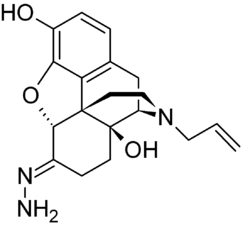- Naloxazone
-
Naloxazone  (5α)- 17-allyl- 3,14-dihydroxy- 4,5-epoxymorphinan- 6-one hydrazoneOther namesNaloxone- 6-hydrazone
(5α)- 17-allyl- 3,14-dihydroxy- 4,5-epoxymorphinan- 6-one hydrazoneOther namesNaloxone- 6-hydrazoneIdentifiers CAS number 73674-85-8 PubChem 9576788 ChEMBL CHEMBL354010 
Jmol-3D images {{#if:C=CCN1CCC23C4C(=NN)CCC2 (C1CC5=C3C(=C(C=C5)O)O4)O|Image 1
- C=CCN1CCC23C4C(=NN)CCC2 (C1CC5=C3C(=C(C=C5)O)O4)O
Properties Molecular formula C19H23N3O3 Molar mass 341.4 g mol−1  (verify) (what is:
(verify) (what is:  /
/ ?)
?)
Except where noted otherwise, data are given for materials in their standard state (at 25 °C, 100 kPa)Infobox references Naloxazone is an irreversible μ opioid receptor antagonist which is selective for the μ1 receptor subtype.[1] Naloxazone produces very long lasting antagonist effects as it forms a covalent bond to the active site of the mu-opioid receptor,[2] thus making it impossible for the molecule to unbind and blocking the receptor permanently until the receptor is recycled by endocytosis.
It has been reported that naloxazone is unstable in acidic solution, dimerizing into the more stable and much more potent antagonist naloxonazine.[3] Under conditions in which no naloxonazine formation could be detected, naloxazone did not display irreversible μ opioid receptor binding.[3]
See also
- Chlornaltrexamine, an irreversible mixed agonist-antagonist
- Oxymorphazone, an irreversible μ-opioid full agonist
References
- ^ Pasternak GW, Childers SR, Snyder SH. "Opiate analgesia: evidence for mediation by a subpopulation of opiate receptors." Science. 1980 May 2; 208(4443):514-6. PMID 6245448. doi:10.1126/science.6245448
- ^ Ling, G. S.; Simantov, R.; Clark, J. A.; Pasternak, G. W. (1986-09-23). "Naloxonazine actions in vivo". European Journal of Pharmacology 129 (1-2): 33–38. doi:10.1016/0014-2999(86)90333-X. PMID 3021478. http://www.sciencedirect.com/science/article/pii/001429998690333X. Retrieved 2011-10-18.
- ^ a b Hahn, E. F.; Pasternak, G. W. (1982-09). "Naloxonazine, a potent, long-lasting inhibitor of opiate binding sites". Life Sciences 31 (12-13): 1385–1388. doi:10.1016/0024-3205(82)90387-3. PMID 6292633. http://www.sciencedirect.com/science/article/pii/0024320582903873. Retrieved 2011-10-18.

This drug article relating to the nervous system is a stub. You can help Wikipedia by expanding it.
